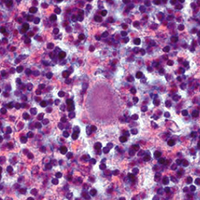Sporadic Creutzfeldt-Jakob disease: Real-Time Quaking Induced Conversion (RT-QuIC) assay represents a major diagnostic advance

Accepted: 7 September 2021
HTML: 24
All claims expressed in this article are solely those of the authors and do not necessarily represent those of their affiliated organizations, or those of the publisher, the editors and the reviewers. Any product that may be evaluated in this article or claim that may be made by its manufacturer is not guaranteed or endorsed by the publisher.
Authors
Sporadic Creutzfeldt-Jakob disease (sCJD) is a rare and fatal neurodegenerative disorder with an incidence of 1.5 to 2 cases per million population/year. The disease is caused by a proteinaceous infectious agent, named prion (or PrPSc), which arises from the conformational conversion of the cellular prion protein (PrPC). Once formed, PrPSc interacts with the normally folded PrPC coercing it to undergo similar structural rearrangement. The disease is highly heterogeneous from a clinical and neuropathological point of view. The origin of this variability lies in the aberrant structures acquired by PrPSc. At least six different sCJD phenotypes have been described and each of them is thought to be caused by a peculiar PrPSc strain. Definitive sCJD diagnosis requires brain analysis with the aim of identifying intracerebral accumulation of PrPSc which currently represents the only reliable biomarker of the disease. Clinical diagnosis of sCJD is very challenging and is based on the combination of several clinical, instrumental and laboratory tests representing surrogate disease biomarkers. Thanks to the advent of the ultrasensitive Real-Time Quaking-Induced Conversion (RT-QuIC) assay, PrPSc was found in several peripheral tissues of sCJD patients, sometimes even before the clinical onset of the disease. This discovery represents an important step forward for the clinical diagnosis of sCJD. In this manuscript, we present an overview of the current applications and future perspectives of RT-QuIC in the field of sCJD diagnosis.
How to Cite

This work is licensed under a Creative Commons Attribution-NonCommercial 4.0 International License.
PAGEPress has chosen to apply the Creative Commons Attribution NonCommercial 4.0 International License (CC BY-NC 4.0) to all manuscripts to be published.
Similar Articles
- A.K. Lindström, D. Hellberg, Immunohistochemical LRIG3 expression in cervical intraepithelial neoplasia and invasive squamous cell cervical cancer: association with expression of tumor markers, hormones, high-risk HPV-infection, smoking and patient outcome , European Journal of Histochemistry: Vol. 58 No. 2 (2014)
- C. Di Nisio, V.L. Zizzari, S. Zara, M. Falconi, G. Teti, G. Tetè, A. Nori, V. Zavaglia, A. Cataldi, RANK/RANKL/OPG signaling pathways in necrotic jaw bone from bisphosphonate-treated subjects , European Journal of Histochemistry: Vol. 59 No. 1 (2015)
- Azzurra Margiotta, Cinzia Progida, Oddmund Bakke, Cecilia Bucci, Characterization of the role of RILP in cell migration , European Journal of Histochemistry: Vol. 61 No. 2 (2017)
- M.L. Escobar Sánchez, O.M. EcheverrÃa MartÃnez, G.H. Vázquez-Nin, Immunohistochemical and ultrastructural visualization of different routes of oocyte elimination in adult rats , European Journal of Histochemistry: Vol. 56 No. 2 (2012)
- L. Bao, Q. Li, Y. Liu, B. Li, X. Sheng, Y. Han, Q. Weng, Immunolocalization of NGF and its receptors in ovarian surface epithelium of the wild ground squirrel during the breeding and nonbreeding seasons , European Journal of Histochemistry: Vol. 58 No. 2 (2014)
- A Cerná, A Cuadrado, N Jouve, SM DÃaz de la Espina, C De la Torre, Z-DNA, a new in situ marker for transcription , European Journal of Histochemistry: Vol. 48 No. 1 (2004)
- Massimo Allegri, Analgesia - Methods and Protocols , European Journal of Histochemistry: Vol. 55 No. 1 (2011)
- P Sirigu, F Piras, L Minerba, D Murtas, C Maxia, R Colombari, A Corbu, MT Perra, J Ugalde, Prognostic prediction of the immunohistochemical expression of p16 and p53 in cutaneous melanoma: a comparison of two populations from different geographical regions , European Journal of Histochemistry: Vol. 50 No. 3 (2006)
- Manuela Malatesta, Histochemistry for nanomedicine: Novelty in tradition , European Journal of Histochemistry: Vol. 65 No. 4 (2021)
- Z Kalnina, K Silina, R Bruvere, N Gabruseva, A Stengrevics, S Barnikol-Watanabe, M Leja, A Line, Molecular characterisation and expression analysis of SEREX-defined antigen NUCB2 in gastric epithelium, gastritis and gastric cancer , European Journal of Histochemistry: Vol. 53 No. 1 (2009)
<< < 34 35 36 37 38 39 40 41 42 43 > >>
You may also start an advanced similarity search for this article.

 https://doi.org/10.4081/ejh.2021.3298
https://doi.org/10.4081/ejh.2021.3298










